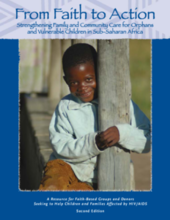The sheer number of orphaned and vulnerable children is overwhelming. Many well-meaning donors are funding orphanages as a solution to the problem. However, orphanages are expensive and can only reach small numbers of children. Research by the World Bank in Tanzania, for example, found the cost of operating orphanages to be six times higher than the cost of caring for children in the community. Most importantly, orphanages separate children from family and community life. They often fail to meet children’s developmental needs and do not prepare them for adult life in the larger society. While institutions can serve as a temporary and last-resort response for children with no other means of support, they are not a recommended long-term solution. The most promising solutions must look to more sustainable alternatives that focus on preventing the conditions that lead to the need for institutional care.
Most donors have a concrete image of what an orphanage looks like. An orphanage is a physical place that can be seen, touched, and visited. In contrast, most donors are not familiar with the programs that help keep children in families. These preventive programs are harder to immediately see and describe, but their benefits can be far greater and they are able to reach many more children.
Many African countries and international organizations recognize the shortcomings of orphanages and discourage their use. They recognize that children may be placed in orphanages by family members who want to care for them but lack the means to do so. Orphanages can become a way to access food, clothing, and an education, when what is really needed is to make these necessities available within the community. When an orphanage is treated as the primary solution, it can weaken a community’s motivation to address orphan issues and divert resources away from the family-based solutions that are better for children.
A common thread that runs through Africa’s diverse cultures is that of extended family members stepping in to provide orphans with a nurturing home and a family, which children need in order to grow into healthy adults. Given the scale and scope of the HIV/AIDS pandemic, it is remarkable that most of the children who have been orphaned continue to be cared for by extended family members. But this safety net is becoming less reliable as more and more caregivers die. Family and community resources are stretched to the breaking point and are in need of support.
©Firelight Foundation

